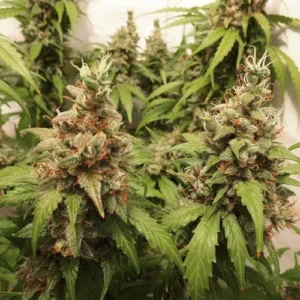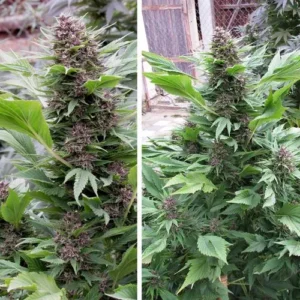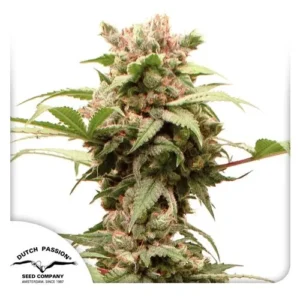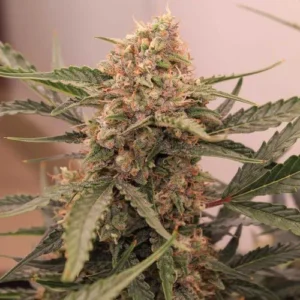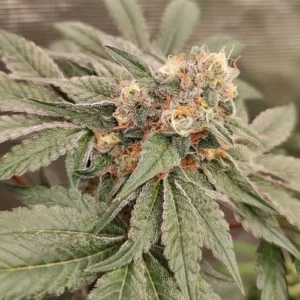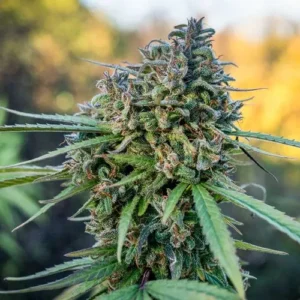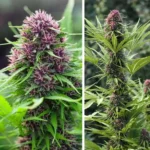
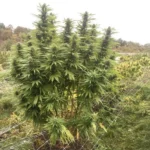
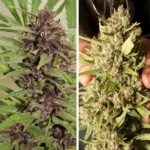
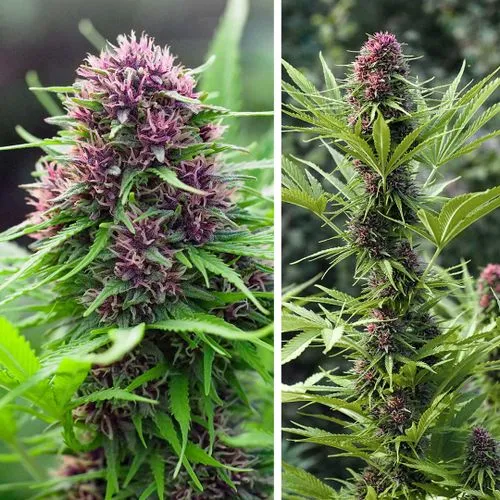
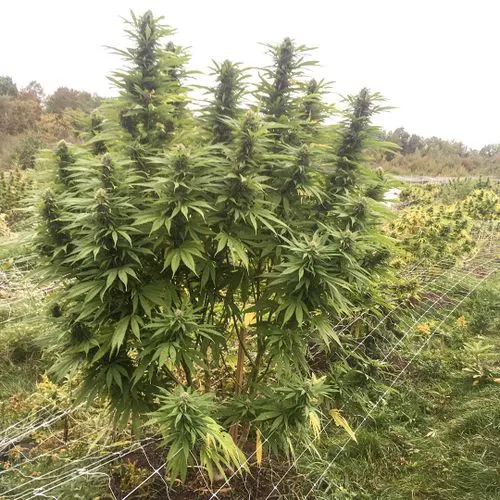
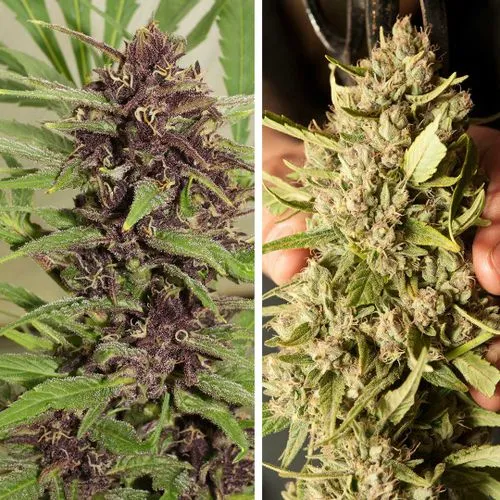
Frisian Dew
Lineage & Origin of Frisian Dew
Frisian Dew is a premium feminized cannabis strain well-known for its unique genetic composition and exceptional qualities. This strain belongs to the Dutch Outdoor family, characterized by its resilience and adaptability to various climates. The lineage of Frisian Dew is derived from a cross between two remarkable strains: Super Skunk and Purple Star. This combination brings together the best attributes of these parent strains, resulting in a hybrid that is celebrated for its performance and quality.
The breeding of Frisian Dew has been executed with meticulous attention to detail. The parents contribute distinct traits, ensuring high potency and robust growth. Super Skunk is lauded for its strength and rich aroma, while Purple Star adds vibrant colors and flavorful notes. This synthesis of genetics creates a plant that not only performs well outdoors but also provides an enriching user experience.
Frisian Dew has gained significant recognition in the cannabis community, earning two prestigious cannabis cups in 2008 and 2018. These wins are a testament to the strain’s quality, potency, and flavor profile. Such accolades highlight its popularity and reliability, making Frisian Dew a sought-after strain among growers and consumers alike.
Sativa or Indica?
Frisian Dew is known primarily as a hybrid strain. This classification indicates that it possesses balanced characteristics from both Sativa and Indica genetics. The hybrid nature of Frisian Dew allows it to deliver a harmonious blend of uplifting and relaxing effects. Users typically report experiencing a euphoric sensation that is both energizing and calming at the same time.
The Sativa influence in Frisian Dew contributes to elevated mood and creativity. Users often find themselves more sociable and engaged in their activities. The Indica genetics offer a soothing quality that enhances relaxation, making it a versatile choice for different occasions. This balance makes Frisian Dew suitable for both daytime and nighttime use depending on the user’s preference.
With its hybrid status, Frisian Dew provides a comprehensive cannabis experience. The blend of energizing and calming effects appeals to a wide audience looking for a well-rounded strain. Whether seeking inspiration for creative pursuits or simply wanting to unwind, Frisian Dew is an excellent option that caters to diverse user needs.
Effects & Flavors of Frisian Dew
The effects of Frisian Dew are often described as a pleasant hybrid high. Users commonly report feelings of euphoria, light-heartedness, and mental clarity. This uplifting sensation is accompanied by a gentle body relaxation that does not compromise productivity, making Frisian Dew an ideal choice for social activities or leisurely tasks.
Flavor plays an essential role in the overall experience of Frisian Dew. This strain offers a complex taste profile characterized by herbal, piney, fruity, and earthy notes. Each inhale reveals a delightful combination of flavors that not only tantalize the taste buds but also enhance the enjoyment of consumption. The richness of these flavors makes Frisian Dew particularly appealing to cannabis enthusiasts.
The overall combination of effects and flavors in Frisian Dew creates a memorable experience for users. The strain’s ability to elicit positive feelings while providing an enjoyable taste sets it apart from many others. Consumers often appreciate the balance of effects and flavors, making Frisian Dew a popular choice among cannabis lovers seeking quality.
Terpenes in Frisian Dew
The terpene profile of Frisian Dew is an integral aspect of its flavor and aroma. Key terpenes present in this strain include β-Caryophyllene, α-Pinene, β-Pinene, Humulene, and Terpineol. Each of these terpenes contributes unique qualities that enhance the overall user experience.
β-Caryophyllene is known for its peppery aroma and potential therapeutic properties. This terpene may interact with cannabinoid receptors, potentially offering anti-inflammatory benefits. The presence of β-Caryophyllene enriches the flavor of Frisian Dew while also addressing wellness needs.
α-Pinene and β-Pinene add fresh, piney notes to the strain’s aroma, creating a refreshing experience. These terpenes are known for their potential cognitive benefits, such as boosting memory retention and focus. Their inclusion adds depth to the flavor profile while enhancing users’ clarity of mind.
Humulene and Terpineol contribute further layers to the strain’s complexity. Humulene brings an earthy scent, potentially offering appetite-suppressing qualities, while Terpineol adds a floral, herbaceous note. Together, these terpenes create a well-rounded and enjoyable consuming experience that elevates the overall enjoyment of Frisian Dew.
Conditions for Germination of Frisian Dew
Successful germination of Frisian Dew seeds requires specific environmental conditions. A warm and humid atmosphere is ideal for promoting healthy sprouting. Maintaining temperatures between 70°F and 85°F facilitates optimal growth during the early stages.
Common methods for germination include utilizing the paper towel technique or direct planting in moist soil. It is crucial to ensure that the seeds remain evenly moist without becoming oversaturated. Proper moisture management prevents seed rot and enhances the chances of successful germination.
By adhering to these essential conditions, growers can ensure high germination rates for Frisian Dew seeds. Healthy seedlings will emerge, laying a strong foundation for robust growth in subsequent phases of cultivation.
Flowering Time of Frisian Dew
The flowering time for Frisian Dew typically ranges from 7 to 9 weeks. This relatively quick flowering period allows growers to enjoy the fruits of their labor sooner, making it appealing for those seeking timely harvests. During this time, plants develop dense and resinous buds, showcasing the quality of the strain’s genetics.
Monitoring plants closely throughout the flowering phase is important for identifying the optimal harvest time. Growers should look for visual cues such as trichome color and bud density. These indicators play a significant role in determining when the buds have reached their peak potency and flavor.
With proper attention during the flowering period, Frisian Dew promises to produce bountiful yields of high-quality buds. The anticipation of harvest is often rewarding for growers, as they can enjoy the fruits of their care and patience.
Indoor and Outdoor Growing Conditions for Frisian Dew
Frisian Dew is adept at growing in both indoor and outdoor environments. For outdoor cultivation, this strain thrives in sunny climates with well-drained soil. Proper care ensures that plants can reach their full potential, developing strong branches and yielding large harvests.
Indoor cultivation of Frisian Dew requires a controlled environment that monitors temperature, humidity, and lighting. By maintaining optimal conditions, growers can produce high yields with quality buds. The very tall stature of Frisian Dew necessitates ample vertical space, making careful planning crucial.
Utilizing training techniques such as topping and low-stress training can help manage plant height effectively. Such methods will encourage horizontal growth and better light exposure to all parts of the plant. This approach enhances healthy bud development and maximizes yield potential.
The versatility of Frisian Dew allows growers to select the best cultivation method for their needs. With the right care, this strain will ensure a delightful growing experience and an enjoyable product for both growers and consumers.
Seed Bank: Dutch Pasion
Type of seed: Feminized
Reviews
There are no reviews yet. Be the first one to write one.
Write a review
Related products

